Concrete Strength Lab Report: Effects of Water/Cement Ratio
VerifiedAdded on 2022/11/11
|9
|1795
|319
Practical Assignment
AI Summary
This lab report investigates the impact of water/cement ratio on the workability and compressive strength of concrete. The experiment involved creating concrete mixes with varying water/cement ratios (0.4, 0.5, and 0.6) and curing some samples in water and others in air. The compressive strength of the concrete cylinders was tested at 7, 14, and 28 days. The results showed that compressive strength increased with the number of curing days and decreased with a higher water/cement ratio. Water-cured samples exhibited higher compressive strength than air-cured samples. The presence of entrained air also negatively affected compressive strength. The report concludes by emphasizing the importance of proper mix design and water/cement ratio selection to achieve desired concrete properties, highlighting potential sources of error and suggestions for improvement in future experiments.
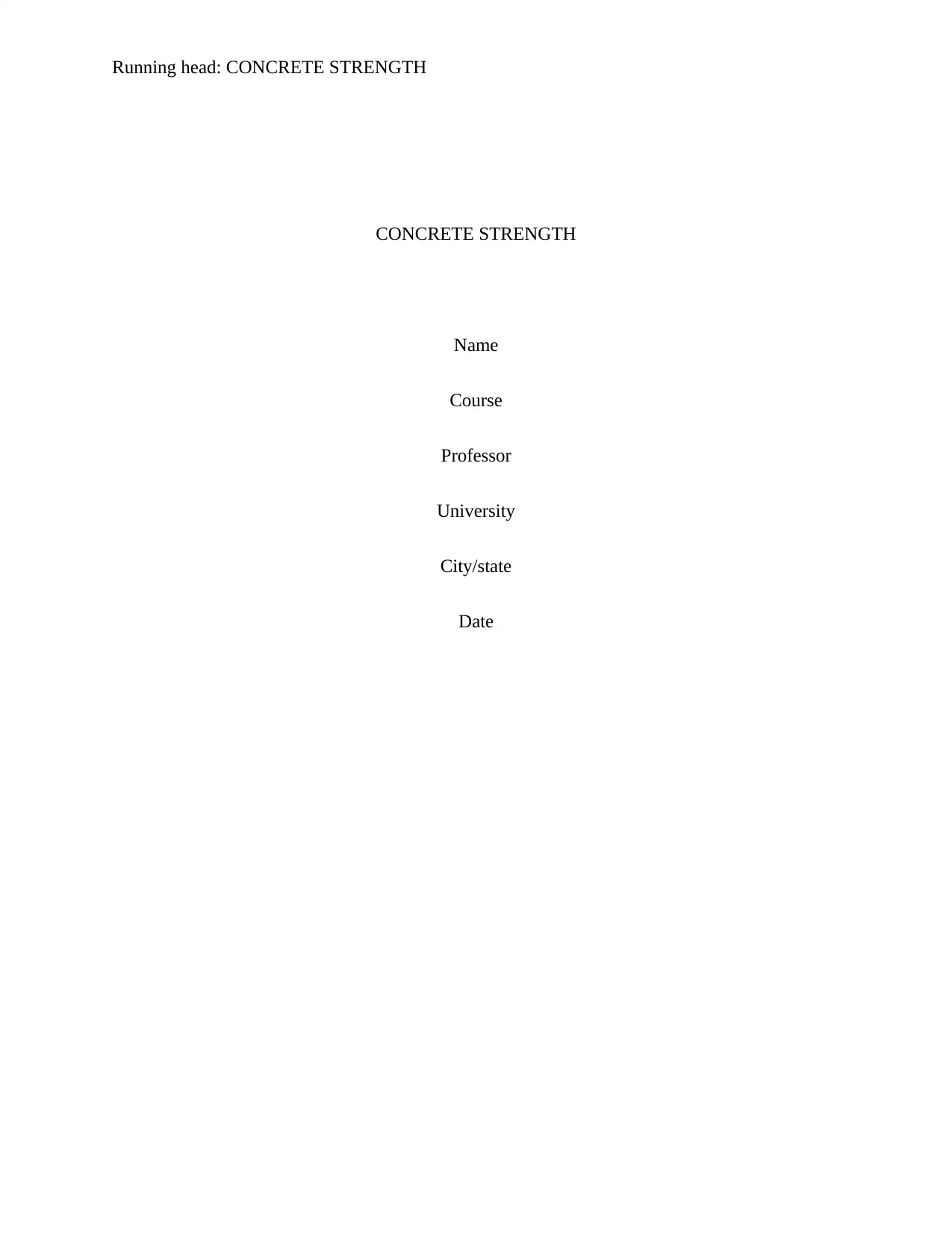
Running head: CONCRETE STRENGTH
CONCRETE STRENGTH
Name
Course
Professor
University
City/state
Date
CONCRETE STRENGTH
Name
Course
Professor
University
City/state
Date
Paraphrase This Document
Need a fresh take? Get an instant paraphrase of this document with our AI Paraphraser
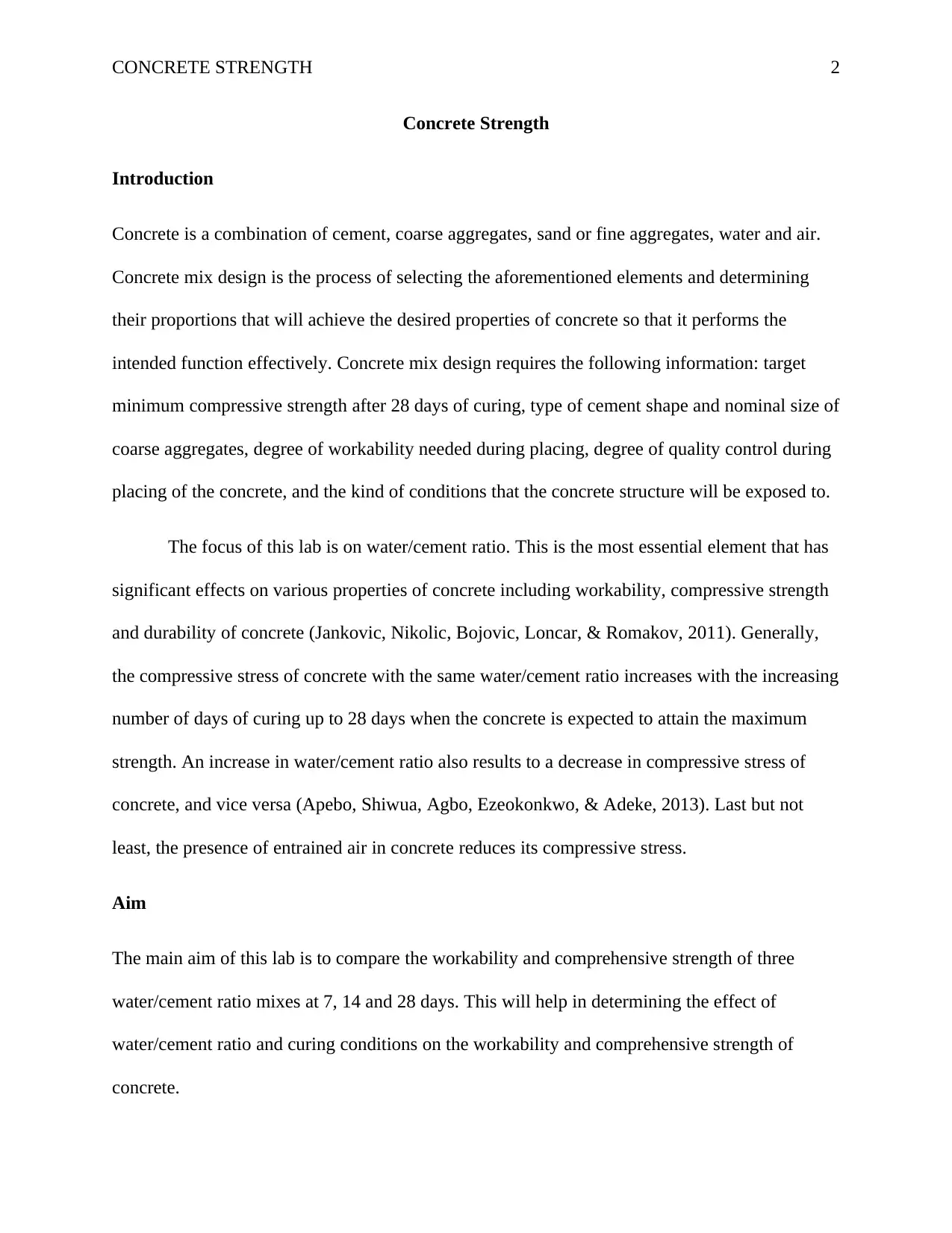
CONCRETE STRENGTH 2
Concrete Strength
Introduction
Concrete is a combination of cement, coarse aggregates, sand or fine aggregates, water and air.
Concrete mix design is the process of selecting the aforementioned elements and determining
their proportions that will achieve the desired properties of concrete so that it performs the
intended function effectively. Concrete mix design requires the following information: target
minimum compressive strength after 28 days of curing, type of cement shape and nominal size of
coarse aggregates, degree of workability needed during placing, degree of quality control during
placing of the concrete, and the kind of conditions that the concrete structure will be exposed to.
The focus of this lab is on water/cement ratio. This is the most essential element that has
significant effects on various properties of concrete including workability, compressive strength
and durability of concrete (Jankovic, Nikolic, Bojovic, Loncar, & Romakov, 2011). Generally,
the compressive stress of concrete with the same water/cement ratio increases with the increasing
number of days of curing up to 28 days when the concrete is expected to attain the maximum
strength. An increase in water/cement ratio also results to a decrease in compressive stress of
concrete, and vice versa (Apebo, Shiwua, Agbo, Ezeokonkwo, & Adeke, 2013). Last but not
least, the presence of entrained air in concrete reduces its compressive stress.
Aim
The main aim of this lab is to compare the workability and comprehensive strength of three
water/cement ratio mixes at 7, 14 and 28 days. This will help in determining the effect of
water/cement ratio and curing conditions on the workability and comprehensive strength of
concrete.
Concrete Strength
Introduction
Concrete is a combination of cement, coarse aggregates, sand or fine aggregates, water and air.
Concrete mix design is the process of selecting the aforementioned elements and determining
their proportions that will achieve the desired properties of concrete so that it performs the
intended function effectively. Concrete mix design requires the following information: target
minimum compressive strength after 28 days of curing, type of cement shape and nominal size of
coarse aggregates, degree of workability needed during placing, degree of quality control during
placing of the concrete, and the kind of conditions that the concrete structure will be exposed to.
The focus of this lab is on water/cement ratio. This is the most essential element that has
significant effects on various properties of concrete including workability, compressive strength
and durability of concrete (Jankovic, Nikolic, Bojovic, Loncar, & Romakov, 2011). Generally,
the compressive stress of concrete with the same water/cement ratio increases with the increasing
number of days of curing up to 28 days when the concrete is expected to attain the maximum
strength. An increase in water/cement ratio also results to a decrease in compressive stress of
concrete, and vice versa (Apebo, Shiwua, Agbo, Ezeokonkwo, & Adeke, 2013). Last but not
least, the presence of entrained air in concrete reduces its compressive stress.
Aim
The main aim of this lab is to compare the workability and comprehensive strength of three
water/cement ratio mixes at 7, 14 and 28 days. This will help in determining the effect of
water/cement ratio and curing conditions on the workability and comprehensive strength of
concrete.
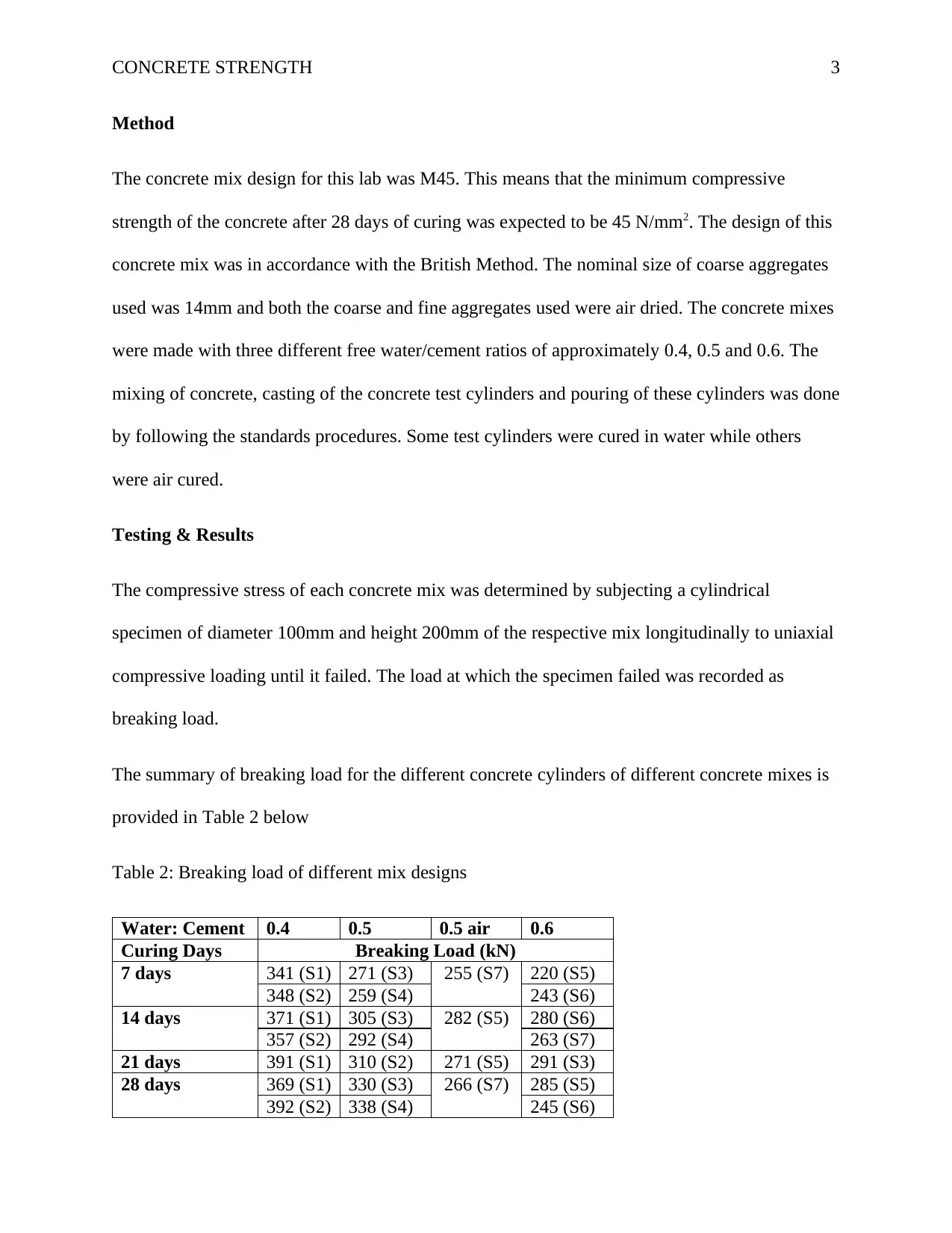
CONCRETE STRENGTH 3
Method
The concrete mix design for this lab was M45. This means that the minimum compressive
strength of the concrete after 28 days of curing was expected to be 45 N/mm2. The design of this
concrete mix was in accordance with the British Method. The nominal size of coarse aggregates
used was 14mm and both the coarse and fine aggregates used were air dried. The concrete mixes
were made with three different free water/cement ratios of approximately 0.4, 0.5 and 0.6. The
mixing of concrete, casting of the concrete test cylinders and pouring of these cylinders was done
by following the standards procedures. Some test cylinders were cured in water while others
were air cured.
Testing & Results
The compressive stress of each concrete mix was determined by subjecting a cylindrical
specimen of diameter 100mm and height 200mm of the respective mix longitudinally to uniaxial
compressive loading until it failed. The load at which the specimen failed was recorded as
breaking load.
The summary of breaking load for the different concrete cylinders of different concrete mixes is
provided in Table 2 below
Table 2: Breaking load of different mix designs
Water: Cement 0.4 0.5 0.5 air 0.6
Curing Days Breaking Load (kN)
7 days 341 (S1) 271 (S3) 255 (S7) 220 (S5)
348 (S2) 259 (S4) 243 (S6)
14 days 371 (S1) 305 (S3) 282 (S5) 280 (S6)
357 (S2) 292 (S4) 263 (S7)
21 days 391 (S1) 310 (S2) 271 (S5) 291 (S3)
28 days 369 (S1) 330 (S3) 266 (S7) 285 (S5)
392 (S2) 338 (S4) 245 (S6)
Method
The concrete mix design for this lab was M45. This means that the minimum compressive
strength of the concrete after 28 days of curing was expected to be 45 N/mm2. The design of this
concrete mix was in accordance with the British Method. The nominal size of coarse aggregates
used was 14mm and both the coarse and fine aggregates used were air dried. The concrete mixes
were made with three different free water/cement ratios of approximately 0.4, 0.5 and 0.6. The
mixing of concrete, casting of the concrete test cylinders and pouring of these cylinders was done
by following the standards procedures. Some test cylinders were cured in water while others
were air cured.
Testing & Results
The compressive stress of each concrete mix was determined by subjecting a cylindrical
specimen of diameter 100mm and height 200mm of the respective mix longitudinally to uniaxial
compressive loading until it failed. The load at which the specimen failed was recorded as
breaking load.
The summary of breaking load for the different concrete cylinders of different concrete mixes is
provided in Table 2 below
Table 2: Breaking load of different mix designs
Water: Cement 0.4 0.5 0.5 air 0.6
Curing Days Breaking Load (kN)
7 days 341 (S1) 271 (S3) 255 (S7) 220 (S5)
348 (S2) 259 (S4) 243 (S6)
14 days 371 (S1) 305 (S3) 282 (S5) 280 (S6)
357 (S2) 292 (S4) 263 (S7)
21 days 391 (S1) 310 (S2) 271 (S5) 291 (S3)
28 days 369 (S1) 330 (S3) 266 (S7) 285 (S5)
392 (S2) 338 (S4) 245 (S6)
⊘ This is a preview!⊘
Do you want full access?
Subscribe today to unlock all pages.

Trusted by 1+ million students worldwide
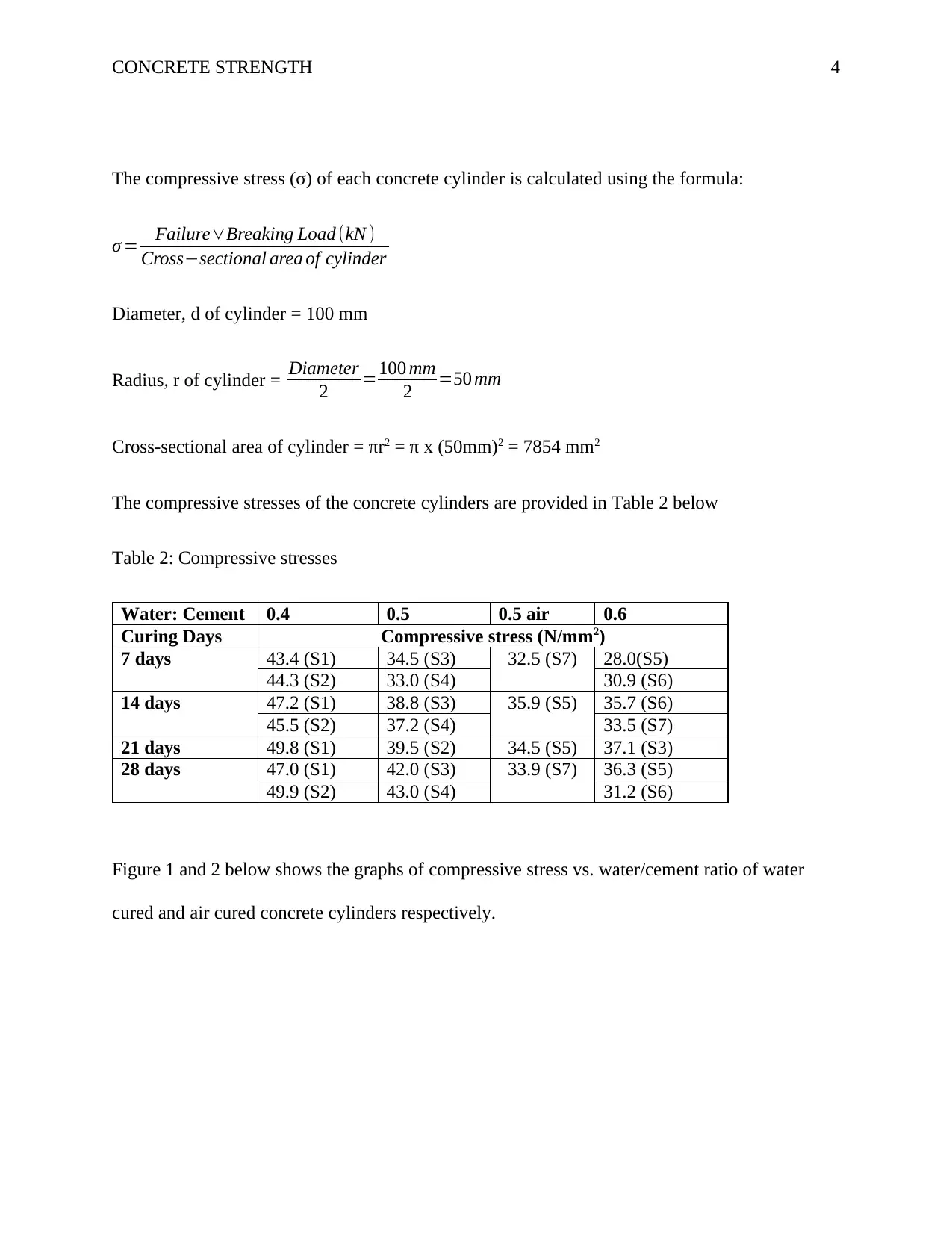
CONCRETE STRENGTH 4
The compressive stress (σ) of each concrete cylinder is calculated using the formula:
σ = Failure∨Breaking Load (kN )
Cross−sectional area of cylinder
Diameter, d of cylinder = 100 mm
Radius, r of cylinder = Diameter
2 =100 mm
2 =50 mm
Cross-sectional area of cylinder = πr2 = π x (50mm)2 = 7854 mm2
The compressive stresses of the concrete cylinders are provided in Table 2 below
Table 2: Compressive stresses
Water: Cement 0.4 0.5 0.5 air 0.6
Curing Days Compressive stress (N/mm2)
7 days 43.4 (S1) 34.5 (S3) 32.5 (S7) 28.0(S5)
44.3 (S2) 33.0 (S4) 30.9 (S6)
14 days 47.2 (S1) 38.8 (S3) 35.9 (S5) 35.7 (S6)
45.5 (S2) 37.2 (S4) 33.5 (S7)
21 days 49.8 (S1) 39.5 (S2) 34.5 (S5) 37.1 (S3)
28 days 47.0 (S1) 42.0 (S3) 33.9 (S7) 36.3 (S5)
49.9 (S2) 43.0 (S4) 31.2 (S6)
Figure 1 and 2 below shows the graphs of compressive stress vs. water/cement ratio of water
cured and air cured concrete cylinders respectively.
The compressive stress (σ) of each concrete cylinder is calculated using the formula:
σ = Failure∨Breaking Load (kN )
Cross−sectional area of cylinder
Diameter, d of cylinder = 100 mm
Radius, r of cylinder = Diameter
2 =100 mm
2 =50 mm
Cross-sectional area of cylinder = πr2 = π x (50mm)2 = 7854 mm2
The compressive stresses of the concrete cylinders are provided in Table 2 below
Table 2: Compressive stresses
Water: Cement 0.4 0.5 0.5 air 0.6
Curing Days Compressive stress (N/mm2)
7 days 43.4 (S1) 34.5 (S3) 32.5 (S7) 28.0(S5)
44.3 (S2) 33.0 (S4) 30.9 (S6)
14 days 47.2 (S1) 38.8 (S3) 35.9 (S5) 35.7 (S6)
45.5 (S2) 37.2 (S4) 33.5 (S7)
21 days 49.8 (S1) 39.5 (S2) 34.5 (S5) 37.1 (S3)
28 days 47.0 (S1) 42.0 (S3) 33.9 (S7) 36.3 (S5)
49.9 (S2) 43.0 (S4) 31.2 (S6)
Figure 1 and 2 below shows the graphs of compressive stress vs. water/cement ratio of water
cured and air cured concrete cylinders respectively.
Paraphrase This Document
Need a fresh take? Get an instant paraphrase of this document with our AI Paraphraser
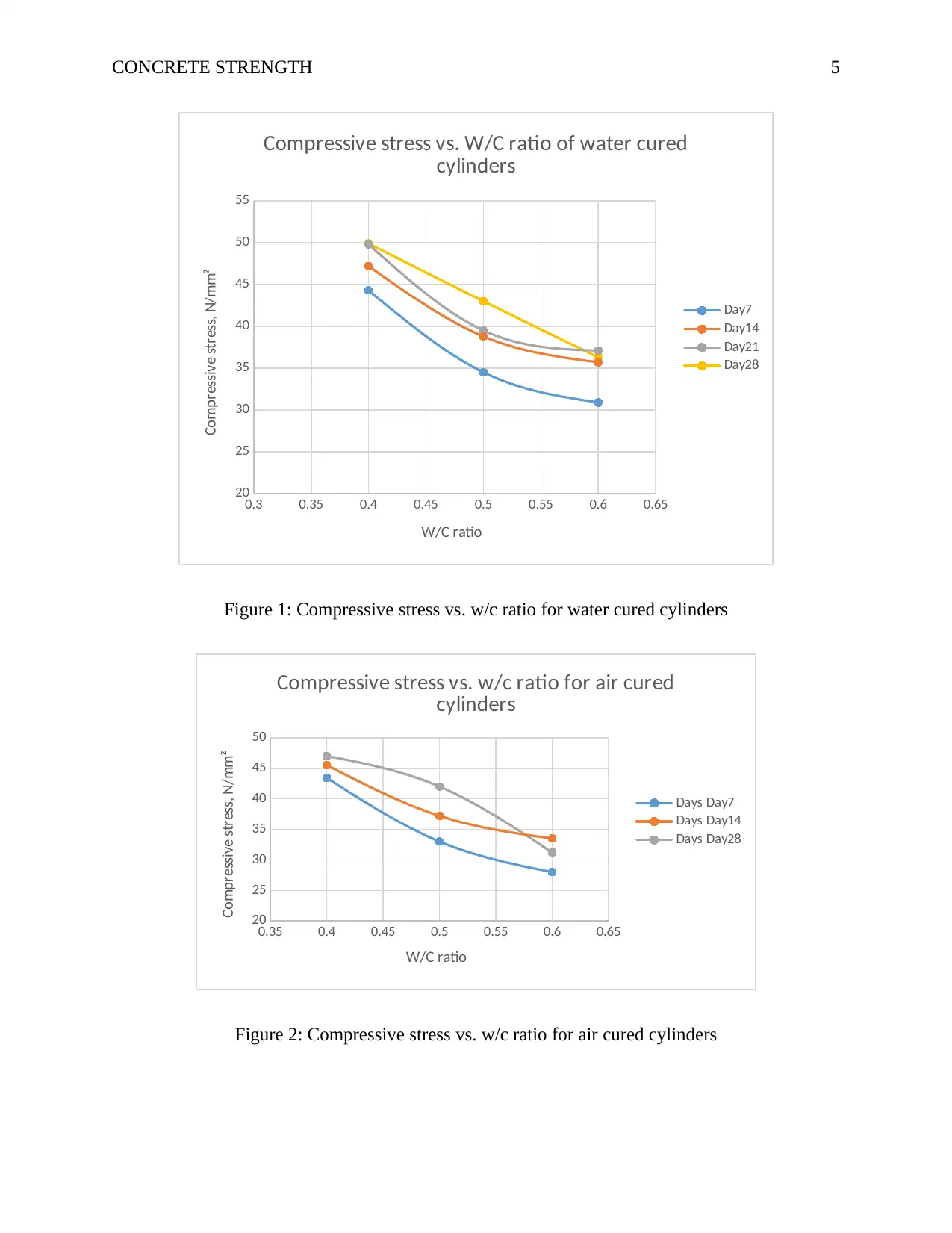
CONCRETE STRENGTH 5
0.3 0.35 0.4 0.45 0.5 0.55 0.6 0.65
20
25
30
35
40
45
50
55
Compressive stress vs. W/C ratio of water cured
cylinders
Day7
Day14
Day21
Day28
W/C ratio
Compressive stress, N/mm²
Figure 1: Compressive stress vs. w/c ratio for water cured cylinders
0.35 0.4 0.45 0.5 0.55 0.6 0.65
20
25
30
35
40
45
50
Compressive stress vs. w/c ratio for air cured
cylinders
Days Day7
Days Day14
Days Day28
W/C ratio
Compressive stress, N/mm²
Figure 2: Compressive stress vs. w/c ratio for air cured cylinders
0.3 0.35 0.4 0.45 0.5 0.55 0.6 0.65
20
25
30
35
40
45
50
55
Compressive stress vs. W/C ratio of water cured
cylinders
Day7
Day14
Day21
Day28
W/C ratio
Compressive stress, N/mm²
Figure 1: Compressive stress vs. w/c ratio for water cured cylinders
0.35 0.4 0.45 0.5 0.55 0.6 0.65
20
25
30
35
40
45
50
Compressive stress vs. w/c ratio for air cured
cylinders
Days Day7
Days Day14
Days Day28
W/C ratio
Compressive stress, N/mm²
Figure 2: Compressive stress vs. w/c ratio for air cured cylinders
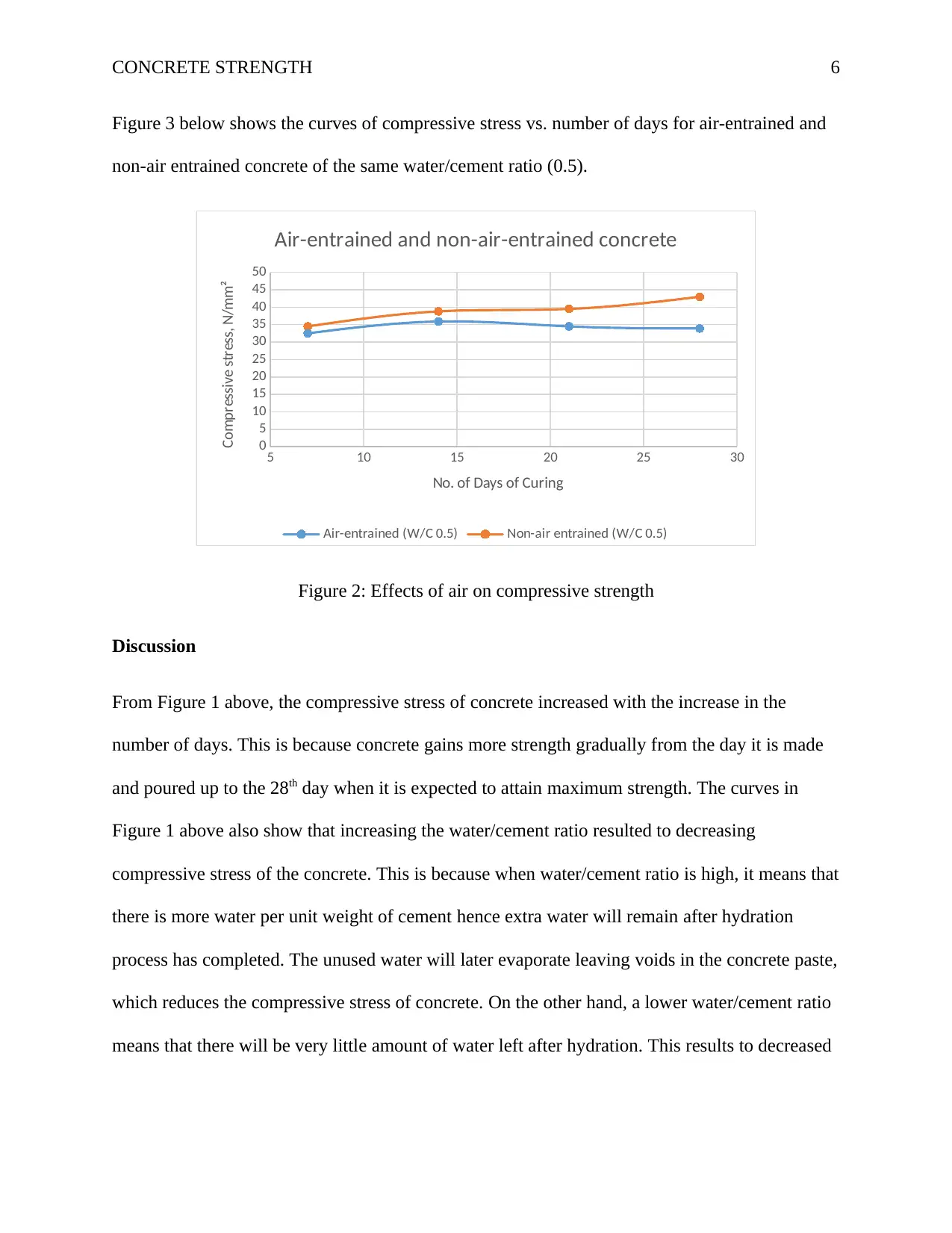
CONCRETE STRENGTH 6
Figure 3 below shows the curves of compressive stress vs. number of days for air-entrained and
non-air entrained concrete of the same water/cement ratio (0.5).
5 10 15 20 25 30
0
5
10
15
20
25
30
35
40
45
50
Air-entrained and non-air-entrained concrete
Air-entrained (W/C 0.5) Non-air entrained (W/C 0.5)
No. of Days of Curing
Compressive stress, N/mm²
Figure 2: Effects of air on compressive strength
Discussion
From Figure 1 above, the compressive stress of concrete increased with the increase in the
number of days. This is because concrete gains more strength gradually from the day it is made
and poured up to the 28th day when it is expected to attain maximum strength. The curves in
Figure 1 above also show that increasing the water/cement ratio resulted to decreasing
compressive stress of the concrete. This is because when water/cement ratio is high, it means that
there is more water per unit weight of cement hence extra water will remain after hydration
process has completed. The unused water will later evaporate leaving voids in the concrete paste,
which reduces the compressive stress of concrete. On the other hand, a lower water/cement ratio
means that there will be very little amount of water left after hydration. This results to decreased
Figure 3 below shows the curves of compressive stress vs. number of days for air-entrained and
non-air entrained concrete of the same water/cement ratio (0.5).
5 10 15 20 25 30
0
5
10
15
20
25
30
35
40
45
50
Air-entrained and non-air-entrained concrete
Air-entrained (W/C 0.5) Non-air entrained (W/C 0.5)
No. of Days of Curing
Compressive stress, N/mm²
Figure 2: Effects of air on compressive strength
Discussion
From Figure 1 above, the compressive stress of concrete increased with the increase in the
number of days. This is because concrete gains more strength gradually from the day it is made
and poured up to the 28th day when it is expected to attain maximum strength. The curves in
Figure 1 above also show that increasing the water/cement ratio resulted to decreasing
compressive stress of the concrete. This is because when water/cement ratio is high, it means that
there is more water per unit weight of cement hence extra water will remain after hydration
process has completed. The unused water will later evaporate leaving voids in the concrete paste,
which reduces the compressive stress of concrete. On the other hand, a lower water/cement ratio
means that there will be very little amount of water left after hydration. This results to decreased
⊘ This is a preview!⊘
Do you want full access?
Subscribe today to unlock all pages.

Trusted by 1+ million students worldwide
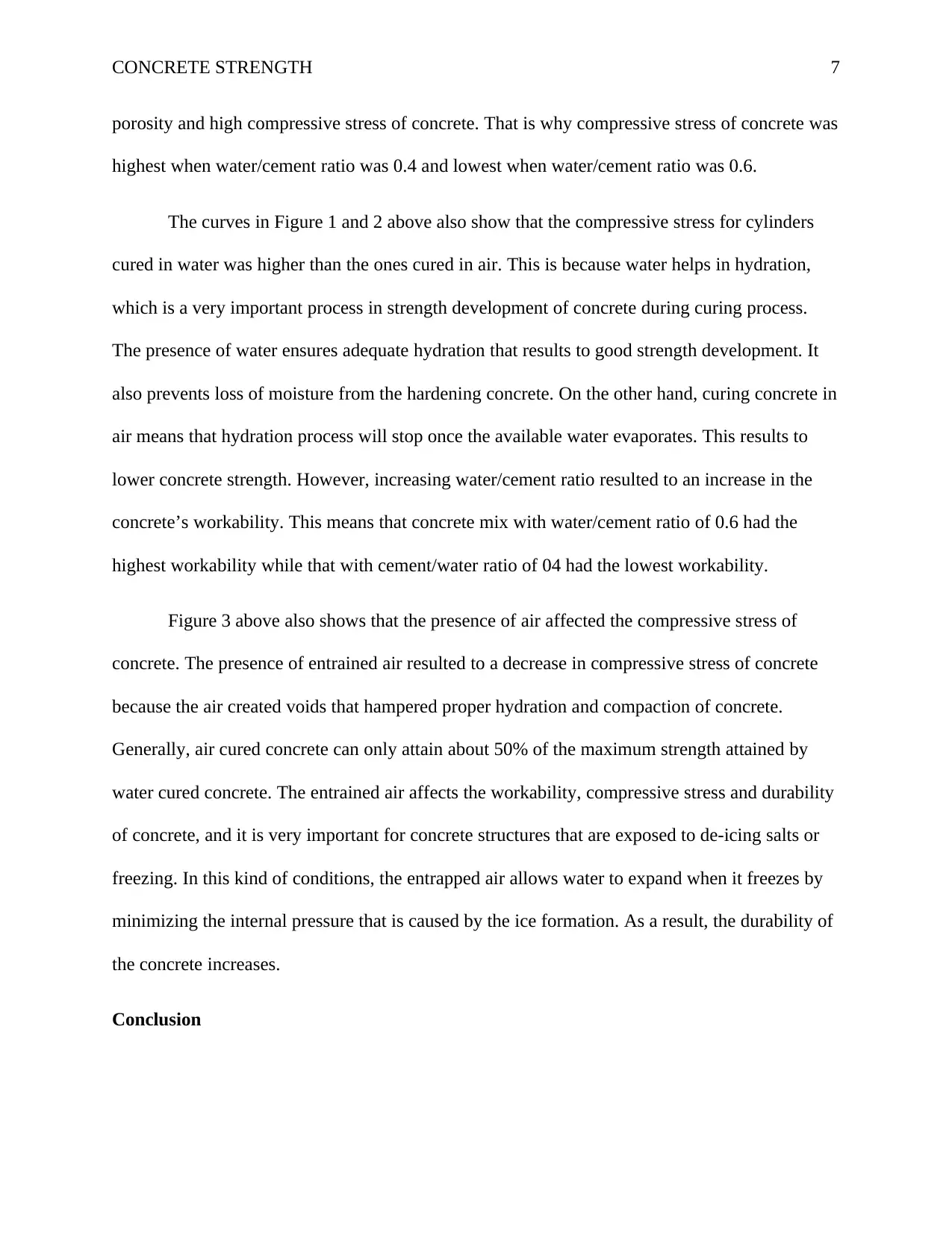
CONCRETE STRENGTH 7
porosity and high compressive stress of concrete. That is why compressive stress of concrete was
highest when water/cement ratio was 0.4 and lowest when water/cement ratio was 0.6.
The curves in Figure 1 and 2 above also show that the compressive stress for cylinders
cured in water was higher than the ones cured in air. This is because water helps in hydration,
which is a very important process in strength development of concrete during curing process.
The presence of water ensures adequate hydration that results to good strength development. It
also prevents loss of moisture from the hardening concrete. On the other hand, curing concrete in
air means that hydration process will stop once the available water evaporates. This results to
lower concrete strength. However, increasing water/cement ratio resulted to an increase in the
concrete’s workability. This means that concrete mix with water/cement ratio of 0.6 had the
highest workability while that with cement/water ratio of 04 had the lowest workability.
Figure 3 above also shows that the presence of air affected the compressive stress of
concrete. The presence of entrained air resulted to a decrease in compressive stress of concrete
because the air created voids that hampered proper hydration and compaction of concrete.
Generally, air cured concrete can only attain about 50% of the maximum strength attained by
water cured concrete. The entrained air affects the workability, compressive stress and durability
of concrete, and it is very important for concrete structures that are exposed to de-icing salts or
freezing. In this kind of conditions, the entrapped air allows water to expand when it freezes by
minimizing the internal pressure that is caused by the ice formation. As a result, the durability of
the concrete increases.
Conclusion
porosity and high compressive stress of concrete. That is why compressive stress of concrete was
highest when water/cement ratio was 0.4 and lowest when water/cement ratio was 0.6.
The curves in Figure 1 and 2 above also show that the compressive stress for cylinders
cured in water was higher than the ones cured in air. This is because water helps in hydration,
which is a very important process in strength development of concrete during curing process.
The presence of water ensures adequate hydration that results to good strength development. It
also prevents loss of moisture from the hardening concrete. On the other hand, curing concrete in
air means that hydration process will stop once the available water evaporates. This results to
lower concrete strength. However, increasing water/cement ratio resulted to an increase in the
concrete’s workability. This means that concrete mix with water/cement ratio of 0.6 had the
highest workability while that with cement/water ratio of 04 had the lowest workability.
Figure 3 above also shows that the presence of air affected the compressive stress of
concrete. The presence of entrained air resulted to a decrease in compressive stress of concrete
because the air created voids that hampered proper hydration and compaction of concrete.
Generally, air cured concrete can only attain about 50% of the maximum strength attained by
water cured concrete. The entrained air affects the workability, compressive stress and durability
of concrete, and it is very important for concrete structures that are exposed to de-icing salts or
freezing. In this kind of conditions, the entrapped air allows water to expand when it freezes by
minimizing the internal pressure that is caused by the ice formation. As a result, the durability of
the concrete increases.
Conclusion
Paraphrase This Document
Need a fresh take? Get an instant paraphrase of this document with our AI Paraphraser
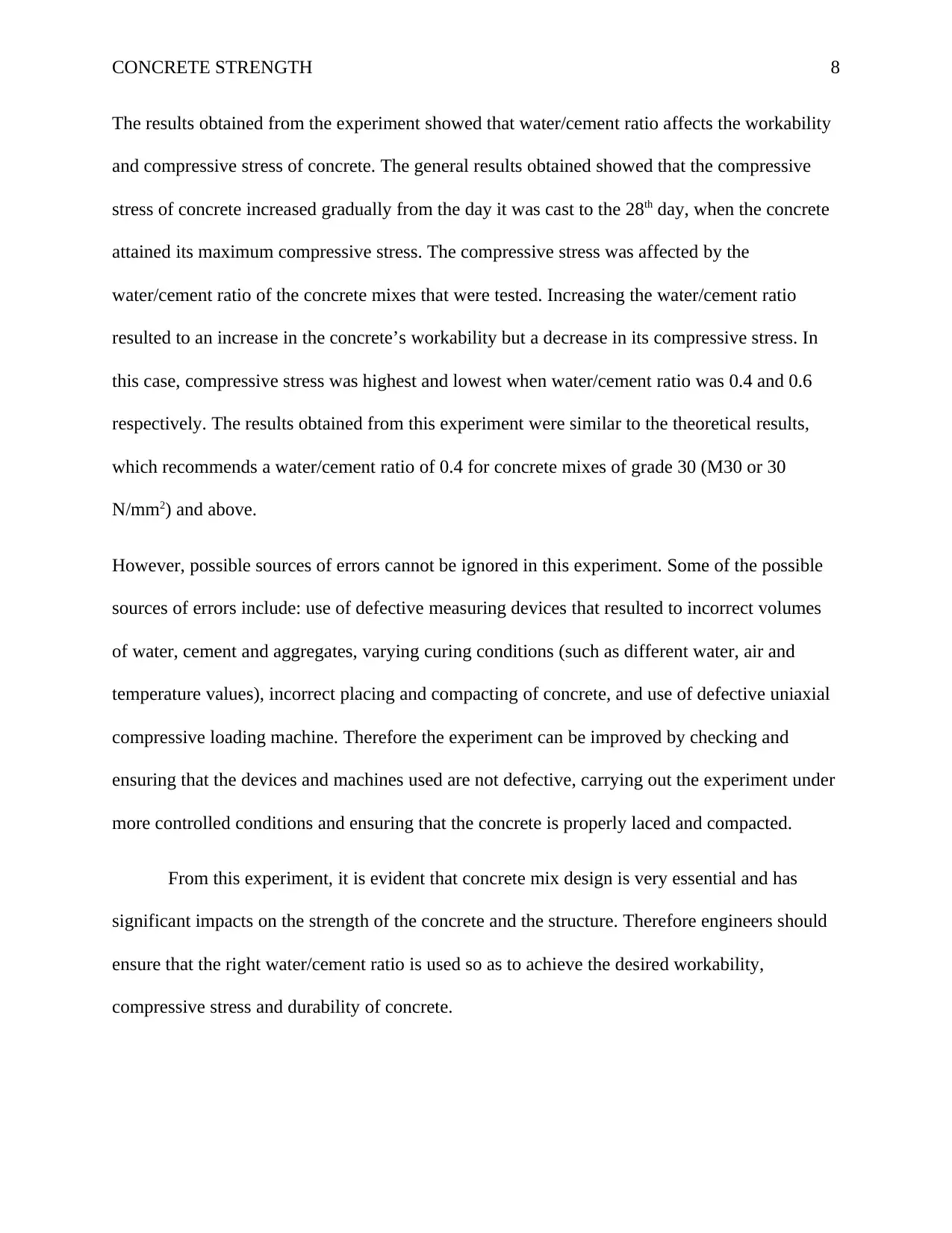
CONCRETE STRENGTH 8
The results obtained from the experiment showed that water/cement ratio affects the workability
and compressive stress of concrete. The general results obtained showed that the compressive
stress of concrete increased gradually from the day it was cast to the 28th day, when the concrete
attained its maximum compressive stress. The compressive stress was affected by the
water/cement ratio of the concrete mixes that were tested. Increasing the water/cement ratio
resulted to an increase in the concrete’s workability but a decrease in its compressive stress. In
this case, compressive stress was highest and lowest when water/cement ratio was 0.4 and 0.6
respectively. The results obtained from this experiment were similar to the theoretical results,
which recommends a water/cement ratio of 0.4 for concrete mixes of grade 30 (M30 or 30
N/mm2) and above.
However, possible sources of errors cannot be ignored in this experiment. Some of the possible
sources of errors include: use of defective measuring devices that resulted to incorrect volumes
of water, cement and aggregates, varying curing conditions (such as different water, air and
temperature values), incorrect placing and compacting of concrete, and use of defective uniaxial
compressive loading machine. Therefore the experiment can be improved by checking and
ensuring that the devices and machines used are not defective, carrying out the experiment under
more controlled conditions and ensuring that the concrete is properly laced and compacted.
From this experiment, it is evident that concrete mix design is very essential and has
significant impacts on the strength of the concrete and the structure. Therefore engineers should
ensure that the right water/cement ratio is used so as to achieve the desired workability,
compressive stress and durability of concrete.
The results obtained from the experiment showed that water/cement ratio affects the workability
and compressive stress of concrete. The general results obtained showed that the compressive
stress of concrete increased gradually from the day it was cast to the 28th day, when the concrete
attained its maximum compressive stress. The compressive stress was affected by the
water/cement ratio of the concrete mixes that were tested. Increasing the water/cement ratio
resulted to an increase in the concrete’s workability but a decrease in its compressive stress. In
this case, compressive stress was highest and lowest when water/cement ratio was 0.4 and 0.6
respectively. The results obtained from this experiment were similar to the theoretical results,
which recommends a water/cement ratio of 0.4 for concrete mixes of grade 30 (M30 or 30
N/mm2) and above.
However, possible sources of errors cannot be ignored in this experiment. Some of the possible
sources of errors include: use of defective measuring devices that resulted to incorrect volumes
of water, cement and aggregates, varying curing conditions (such as different water, air and
temperature values), incorrect placing and compacting of concrete, and use of defective uniaxial
compressive loading machine. Therefore the experiment can be improved by checking and
ensuring that the devices and machines used are not defective, carrying out the experiment under
more controlled conditions and ensuring that the concrete is properly laced and compacted.
From this experiment, it is evident that concrete mix design is very essential and has
significant impacts on the strength of the concrete and the structure. Therefore engineers should
ensure that the right water/cement ratio is used so as to achieve the desired workability,
compressive stress and durability of concrete.
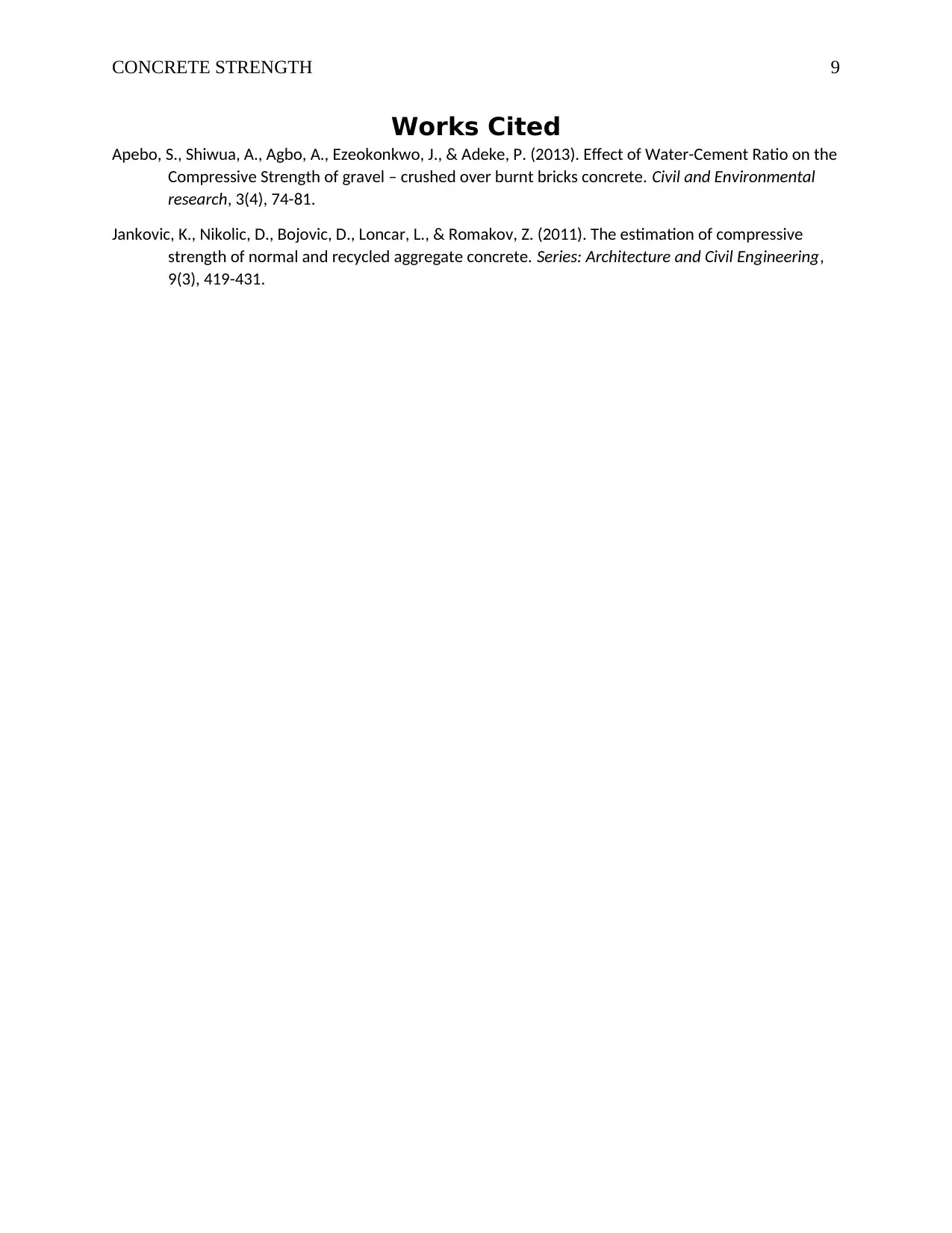
CONCRETE STRENGTH 9
Works Cited
Apebo, S., Shiwua, A., Agbo, A., Ezeokonkwo, J., & Adeke, P. (2013). Effect of Water-Cement Ratio on the
Compressive Strength of gravel – crushed over burnt bricks concrete. Civil and Environmental
research, 3(4), 74-81.
Jankovic, K., Nikolic, D., Bojovic, D., Loncar, L., & Romakov, Z. (2011). The estimation of compressive
strength of normal and recycled aggregate concrete. Series: Architecture and Civil Engineering,
9(3), 419-431.
Works Cited
Apebo, S., Shiwua, A., Agbo, A., Ezeokonkwo, J., & Adeke, P. (2013). Effect of Water-Cement Ratio on the
Compressive Strength of gravel – crushed over burnt bricks concrete. Civil and Environmental
research, 3(4), 74-81.
Jankovic, K., Nikolic, D., Bojovic, D., Loncar, L., & Romakov, Z. (2011). The estimation of compressive
strength of normal and recycled aggregate concrete. Series: Architecture and Civil Engineering,
9(3), 419-431.
⊘ This is a preview!⊘
Do you want full access?
Subscribe today to unlock all pages.

Trusted by 1+ million students worldwide
1 out of 9
Related Documents
Your All-in-One AI-Powered Toolkit for Academic Success.
+13062052269
info@desklib.com
Available 24*7 on WhatsApp / Email
![[object Object]](/_next/static/media/star-bottom.7253800d.svg)
Unlock your academic potential
Copyright © 2020–2025 A2Z Services. All Rights Reserved. Developed and managed by ZUCOL.





